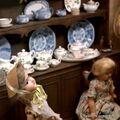Category:The Dolls House (display)
| Display Area |
|---|
 |
| 12 - The Dolls House (display) Arch Two |
| –– 01 02 03 04 05 06 07 08 09
10 11 12 13 14 15 16 17 18 19 20 21 22 23 24 25 26 27 28 29 30 31 32 33 34 35 36 37 38 39 40 41 42 43 44 45 46 47 48 49 50 51 52 53 54 55 –– 57 58 –– –– 61 62 63 64 65 66 67 –– –– –– 71 72 73 74 –– 76 77 78 79 80 81 82 83 84 85 86 –– –– –– |
A precious and instructive collection of dolls covering an important period of doll manufacture between 1875-1930 with examples of some of the most famous and collectible names in dollmaking, from Germany, France and Britain including: Bru, Kammer and Reinhardt, Armand Marseille, Max Hardwick and Simon and Halbig.
Early dolls
Dolls have been cherished playthings since ancient times. There is an example on display in the British Museum of a woven doll from a Roman grave of 300 B.C., and the making of homemade dolls from wicker, twigs, or sewn rags is a traditional craft that probably goes back to the prehistoric era. However, most surviving dolls date from the late Nineteenth Century, when they began to be produced on a commercial scale.
Construction materials
While a great deal of the fascination for dolls must be in the haunting quality of their lifelike little faces, they also invoke a feeling for the periods that they represent with much to be gleaned about the fashions, clothes, jewellery, shoes, even hairstyles of the times.
In order to obtain these lifelike qualities, especially in the skin and face, a variety of materials were employed and experimented with, including porcelain, wax, fabric, wood and papier-mâché.
Chinadolls became popular during the middle of the Nineteenth Century and Germany began exporting large quantities of dolls, mainly of wood, composition, porcelain and bisque (unglazed porcelain) giving rise to famous names of the time such as: Armand Marseille, Max Hardwick, Simon and Halbig and Kämmer & Reinhardt who in particular made their now highly sought-after character dolls using the faces of actual children.
Britain is more noted for "poured-wax" dolls and paper dolls, but without a doubt the most "chic" dolls were produced in France with the likes of Bru's and Emile Jumeau's Bébé dolls now highly prized.
External links
Pages in category ‘The Dolls House (display)’
The following 28 pages are in this category, out of 28 total.
B
- Baby rattle and pacifier in silver and coral (C18th)
- Bisque composition doll, c1900 (Max Handwerck)
- Bisque doll, c1900 (Armand Marseille)
- Bisque doll, c1909 (Germany)
- Bisque-headed Afro-European doll, c1930 (Armand Marseille)
- Bisque-headed boy doll, c1920 (Simon and Halbig)
- Bisque-headed doll with mohair wig, c1900 (Schoenau and Hoffmeister)
- Bisque-headed doll, c1900s (Armand Marseille)
- Bisque-headed doll, c1900s (J D Kestner)
- Bisque-headed googly-eyed baby doll, c1900 (Germany)
C
D
P
Media in category ‘The Dolls House (display)’
The following 2 files are in this category, out of 2 total.
- Area 12.jpg 800 × 798; 361 KB
- Baby rattle and pacifier, C18th.jpg 1,800 × 1,012; 1.01 MB





